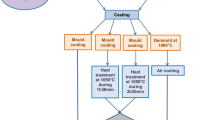Abstract
Heat treatment is a way to reduce the degree of chemical and structural inhomogeneity of cast protectors used to protect metallic structures from electrochemical corrosion. The present paper describes results of a study of the effect of various heat-treatment regimes on the structure and the main electrochemical properties of specimens of alloys TsP1, AP1, and MP1, used for the production of protectors.
Similar content being viewed by others
References
E. Ya. Lyublinskii and V. D. Pirogov (eds.),Corrosion and Protection of Ships [in Russian], Sudostroenie, Leningrad (1987).
V. A. Kechin, “Main principles of the creation of protector alloys,”Izv. Vuzov, Tsret. Metal., No. 5, 97–102 (1986).
E. Ya. Lyublinskii,Electrochemical Protection from Corrosion [in Russian], Metallurgiya, Moscow (1987).
V. A. Kechin and E. Ya. LyublinskiiZinc Alloys [in Russian], Metallurgiya, Moscow (1986).
Author information
Authors and Affiliations
Additional information
Translated from Metallovedenie i Termicheskaya Obrabotka Metallov, No. 12, pp. 22–24, December, 1997.
Rights and permissions
About this article
Cite this article
Kechin, V.A., Solozhenko, V.L. Effect of the heat-treatment regime on the structure and properties of protector alloys. Met Sci Heat Treat 39, 525–527 (1997). https://doi.org/10.1007/BF02471372
Issue Date:
DOI: https://doi.org/10.1007/BF02471372




